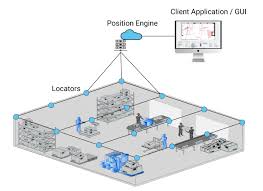Indoor Positioning System: Revolutionizing Navigation Indoors
An indoor positioning system (IPS) is a technology that enables precise navigation and tracking of objects or people within enclosed spaces such as buildings, airports, shopping malls, and warehouses. While GPS works well outdoors, it struggles to provide accurate location data indoors due to signal blockages and reflections.
IPS utilizes a combination of hardware and software components to determine the position of a device or individual in real-time. Different technologies like Wi-Fi, Bluetooth, RFID, ultrasonic sensors, and infrared are commonly used in IPS systems to triangulate positions.
One of the key applications of indoor positioning systems is in enhancing the visitor experience in large venues such as museums or exhibition centers. By deploying IPS technology, visitors can receive interactive maps, personalized recommendations, and location-based notifications on their smartphones.
In retail environments, IPS can be utilized to track customer movements within stores, analyze foot traffic patterns, optimize store layouts, and send targeted promotions based on the shopper’s location. This not only improves the shopping experience but also helps retailers boost sales and customer engagement.
Indoor positioning systems also play a crucial role in improving workplace efficiency by enabling asset tracking, employee monitoring for safety purposes, and optimizing logistics operations within warehouses. By providing real-time location data, businesses can streamline their operations and reduce operational costs.
As IPS technology continues to evolve with advancements in sensor accuracy and data processing capabilities, its potential applications are expanding across various industries. From healthcare facilities ensuring patient safety to smart homes enabling automation based on occupant locations, indoor positioning systems are revolutionizing how we navigate and interact with indoor spaces.
5 Essential Tips for Optimizing Your Indoor Positioning System
- Ensure proper calibration of sensors for accurate indoor positioning.
- Utilize a combination of technologies such as Wi-Fi, Bluetooth, and RFID for better coverage.
- Consider the deployment of anchor nodes strategically to improve location accuracy.
- Regularly update and maintain the indoor maps used in the positioning system.
- Test the system extensively in different scenarios to identify and address any potential issues.
Ensure proper calibration of sensors for accurate indoor positioning.
Ensuring proper calibration of sensors is crucial for achieving accurate indoor positioning with an indoor positioning system (IPS). Calibration helps fine-tune sensor readings and minimize errors, resulting in more precise location tracking within indoor environments. By calibrating sensors effectively, users can enhance the reliability and performance of their IPS, enabling seamless navigation and tracking experiences indoors.
Utilize a combination of technologies such as Wi-Fi, Bluetooth, and RFID for better coverage.
To enhance indoor positioning system coverage and accuracy, it is recommended to leverage a combination of technologies such as Wi-Fi, Bluetooth, and RFID. By integrating these different technologies, businesses and organizations can achieve more comprehensive location tracking capabilities. Wi-Fi provides broad coverage and reliable connectivity, while Bluetooth offers precise proximity detection for close-range tracking. RFID technology can be used for asset identification and tracking in specific areas. By combining these technologies strategically, indoor positioning systems can deliver more robust and reliable location data for a wide range of applications across various industries.
Consider the deployment of anchor nodes strategically to improve location accuracy.
When implementing an indoor positioning system, it is crucial to consider strategically deploying anchor nodes to enhance location accuracy. Anchor nodes serve as reference points for triangulating positions within the indoor space. By strategically placing these nodes in key locations, such as corners or areas with minimal signal interference, the system can more accurately determine the position of devices or individuals. This strategic deployment of anchor nodes not only improves location accuracy but also enhances the overall performance and reliability of the indoor positioning system, ensuring users receive precise and reliable location information for a seamless navigation experience.
Regularly update and maintain the indoor maps used in the positioning system.
Regularly updating and maintaining the indoor maps used in the positioning system is crucial for ensuring accurate and reliable location data. By keeping the maps up-to-date with any changes in the indoor environment, such as new walls, furniture layouts, or equipment installations, the positioning system can provide users with precise navigation guidance. Additionally, regular maintenance helps to address any potential errors or inaccuracies that may arise over time, ensuring that the system operates efficiently and effectively in delivering seamless indoor positioning experiences.
Test the system extensively in different scenarios to identify and address any potential issues.
To ensure the effectiveness and reliability of an indoor positioning system, it is crucial to thoroughly test the system in various scenarios. By conducting extensive testing across different environments and conditions, potential issues and limitations can be identified and addressed proactively. This approach allows for fine-tuning of the system to optimize accuracy, performance, and user experience, ultimately enhancing the overall functionality and usability of the indoor positioning technology.
Tags: accurate location data indoors, airports, buildings, enclosed spaces, gps, hardware components, indoor positioning system, ips, objects, people, precise navigation, real-time position determination, reflections, revolutionizing navigation indoors, shopping malls, signal blockages, software components, technology, tracking, warehouses
